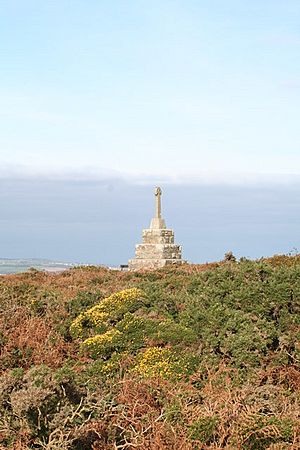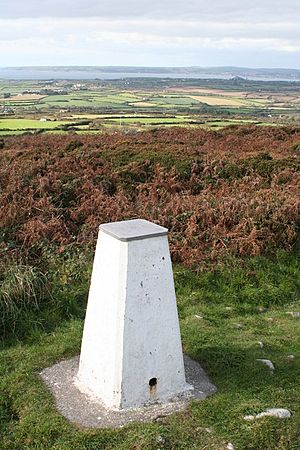Tregonning Hill facts for kids
| Site of Special Scientific Interest | |

Germoe war memorial, on the summit of the hill
|
|
| Area of Search | Cornwall |
|---|---|
| Coordinates | 50°07′06″N 5°21′18″W / 50.1184°N 5.3551°W |
| Interest | Biological |
| Area | 5.21 hectares (0.05 km2; 0.02 sq mi) |
| Notification | 1994 |
Tregonning Hill is a cool granite hill in west Cornwall, England. It looks out over Mount's Bay. It's about 6 kilometers west of Helston. This hill is super important because of its clay!
A chemist named William Cookworthy found special clay here. He mixed it with another rock called china stone. This mix helped him create Plymouth porcelain. This was the very first time porcelain was made in Europe!
Part of Tregonning Hill is a special protected area. It's called a Site of Special Scientific Interest (SSSI). In 1994, it was the only place in Great Britain where a rare plant, western rustwort, was known to grow.
Contents
Wildlife on Tregonning Hill
Tregonning Hill is home to different types of plants. You'll find areas of lowland heath and scrub. Heathland is like a wild garden with lots of heather.
The heath has plants like common heather, bell heather, and western gorse. In wetter spots, you might see cross-leaved heath. Other plants like bilberry and tormentil also grow here.
On deeper soils, you'll find European gorse, bracken, and bramble. These plants form thicker scrub areas.
Rare Plants and Mosses
The bare slopes of the old clay works are special. This is where the rare western rustwort grows. By 2004, this liverwort was found in fourteen places in Cornwall. This makes Cornwall a very important place for this plant worldwide!
Another rare plant, a moss called Brachydontium trichodes, also lives on Tregonning Hill. It's only known from two places in Cornwall.
Unfortunately, in 2010, the special protected area of the hill was not doing as well. It was considered to be "unfavourable declining." This means it needs help to stay healthy.
History of Tregonning Hill
The top of Tregonning Hill has an ancient Iron Age hillfort called Castle Pencaire. A hillfort is like an old fort built on a hill. There are also two "rounds" and an old field system. These are all protected as a "multi-period archaeological landscape."
However, trees and bushes are growing over these old sites. This means they are not in good condition. They are on a list called the Heritage at Risk Register. This list helps keep track of important historical sites that need care.
Germoe War Memorial
The Germoe war memorial is also on the very top of the hill. It's inside the old hillfort. This memorial is a Grade II listed building. This means it's an important historical structure.
Mining and Industry
Tregonning Hill is made of a type of rock called granite. This granite has been changed by a process called kaolinization. This process turns the granite into china clay. You can still see old pits, gullies, and waste piles from mining on the hillside.
In 1745, a chemist named William Cookworthy visited the area. He noticed a very fine clay being used to fix furnaces. Cookworthy had already figured out how to make hard porcelain. At that time, porcelain mostly came from China.
He searched for the right clay to make porcelain in Europe. He found that the clay from Tregonning Hill was perfect when mixed with china stone. He then got permission to mine the clay from the hill. The clay was sent from Porthleven to Plymouth.
In the 1870s, china clay from Tregonning Hill was shipped from Porthleven. Later, in 1880, china clay and fire bricks were also sent to New York from Hayle.
Brickworks on the Hill
In the early 1870s, the Tregonning Hill China Clay and Brick Works started. A man named William Argall set it up. He had help from two ironfounders, William Harvey and John Toy.
Today, only one part of the old brickworks can still be seen. It's a type of oven called a Scrivener kiln. In the early 1880s, about ten people worked at the brickworks. They made around 150,000 bricks each year!
Historic England believes this partly ruined kiln is from the 1700s. It was also given a Grade II listing in 1987. By 1907, maps showed that the site was no longer being used.
An elvan quarry, which is a type of stone quarry, was also working on the top of the hill in 1879.
Religion and Community
In 1880, a local newspaper reported on a yearly tradition. Children from the Ashtown Free Church Sunday school would walk in a parade. They would go to an "old amphitheatre" on the hill for a special sermon. This shows how the hill was used by the local community.


